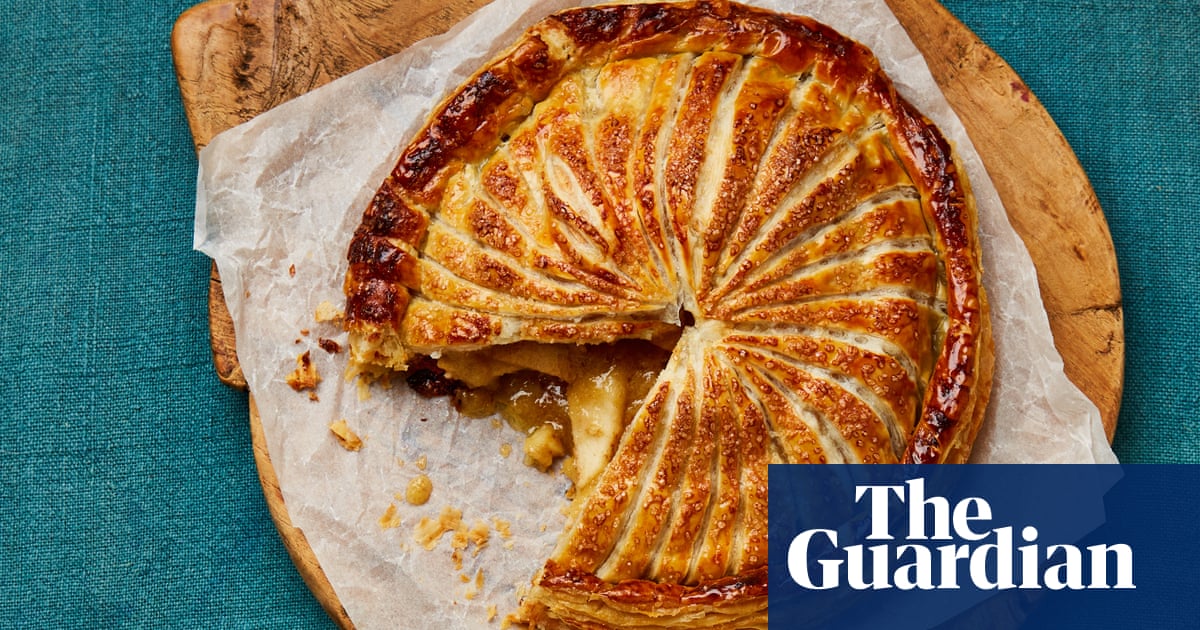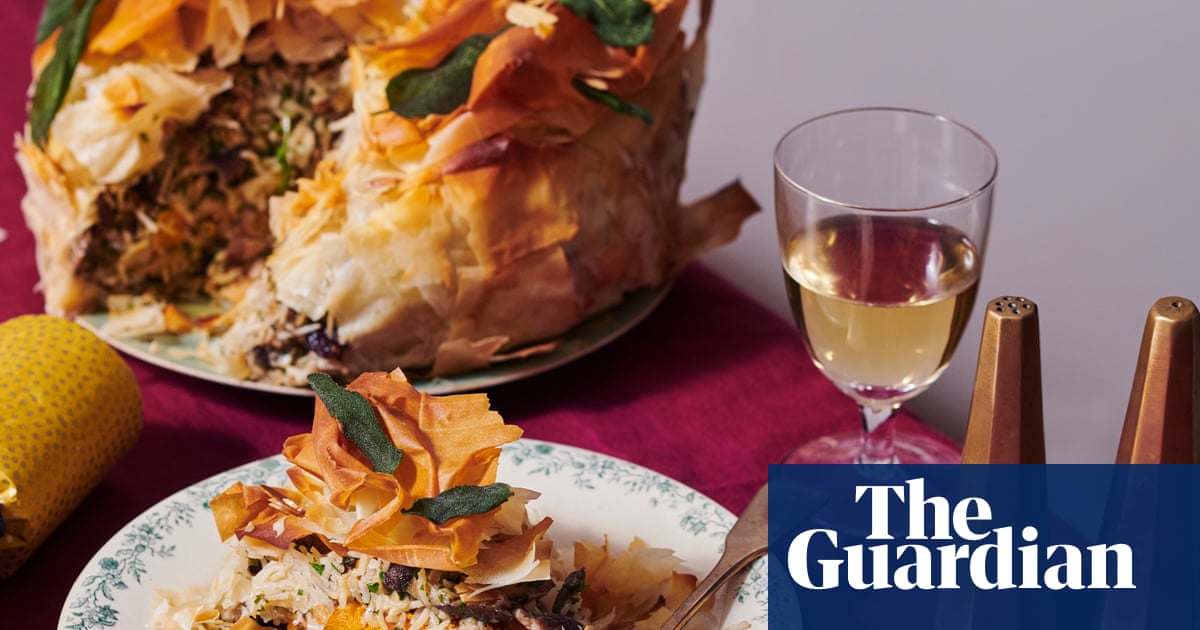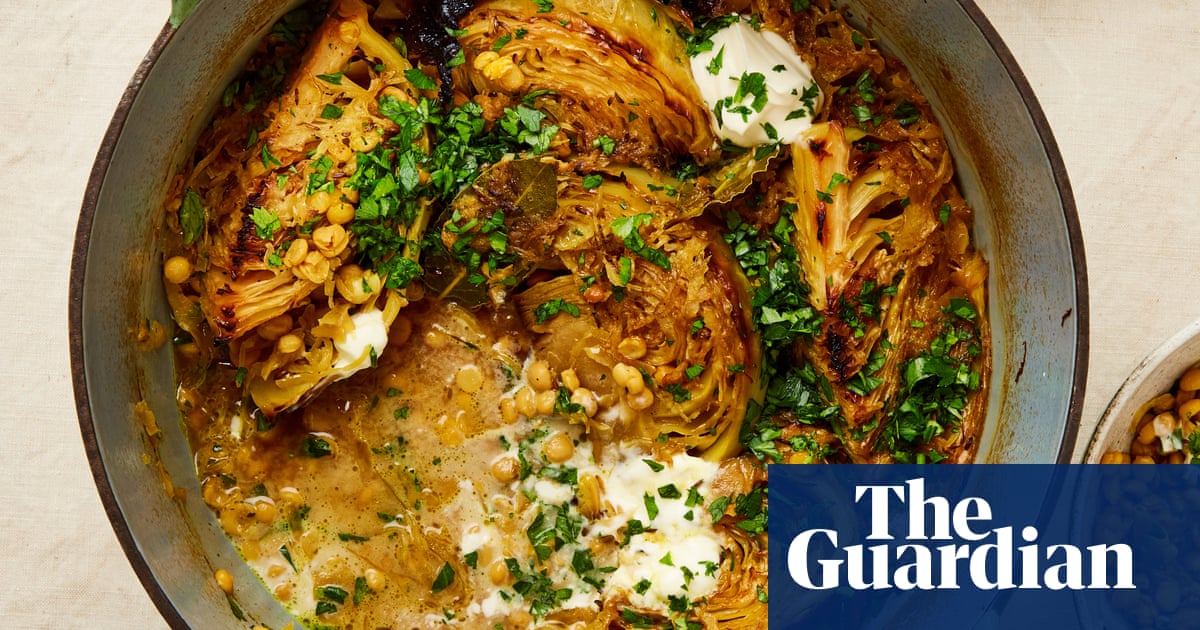
There are few things more festive than a festive dessert. They offer the most jolly excuse (not that we need one at this time of the year) to pile all sorts of sweet, seasonal flavours into a tart or on to a plate. Caramelised nuts, plates dusted with icing sugar, boozy double cream, cinnamon and allspice, dried fruit … so bring me some figgy pudding (and then some!) indeed!
Piloncillo tart (pictured top)
Piloncillo is an unrefined, dark sugar from Mexico, packed full of organic impurities that give it a complex, molasses flavour that’s similar to jaggery or panela. You can buy it in Latin and South American food shops, but if you can’t get hold of any, use jaggery instead. The dough can be made ahead of time, and even frozen. You will have lots of egg whites left over, which is the perfect excuse to make some snowy-looking, festive meringues (otherwise, freeze them for another time). This tart benefits hugely from a night in the fridge after baking.
Prep 10 min
Chill 1 hr
Cook 2 hr
Rest 1 hr
Serves 12
For the tart case
150g plain flour, plus extra for dusting
40g fine cornmeal, or polenta
135g fridge-cold unsalted butter, cut into small cubes
25g caster sugar
½ tsp allspice
½ tsp cinnamon
1 tsp finely grated lime zest
Fine sea salt, plus flaked sea salt to finish
50ml fridge-cold whole milk
1 egg yolk
1 tsp double cream
For the filling
220g piloncillo, finely grated, or jaggery or dark brown sugar
50ml Pedro Ximénez, or marsala or madeira
750ml double cream
11 egg yolks
25g caster sugar
First, make the dough. Put the first seven ingredients and a quarter-teaspoon of fine sea salt in the bowl of a food processor and pulse until the mix resembles breadcrumbs. Tip into a large bowl, then gradually add the milk, mixing constantly, until everything comes together into a dough. Tip out on to a lightly floured work surface and knead gently just to bring it together – it should be slightly tacky, but not stick to your hands. Wrap and chill for at least an hour.
Take the dough out of the fridge, put it on a well-floured work surface and roll out into a 38cm circle about 2mm thick. Loosely roll the pastry around the pin, then carefully lift and place over a 2½cm-deep 28cm fluted tart case. Using your hands, quickly press the dough into the corners and sides of the tin, leaving any overhang. Cover with a large sheet of greaseproof paper, fill with baking beans, then return to the fridge for another hour.
Heat the oven to 200C (180C)/390F/gas 6. Cut any overhanging pastry off the tart case and set aside, then bake the case for 30 minutes, until the edges turn golden. Lift out the paper and beans, use the reserved excess pastry to patch up any holes, then bake for another 20 minutes, until the base is lightly browned. Whisk the egg yolk and cream in a small bowl, brush all over the exposed pastry, then return to the oven for just two minutes more. Remove and leave to cool.
Turn down the oven to 160C (140C fan)/325F/gas 3. Now make the filling. Melt the piloncillo in a large saucepan on a medium-high heat, swirling the pan gently until the sugar is completely liquid. Off the heat, carefully stir in the sherry, then return to a low heat and whisk in the cream.
In a large bowl, whisk the egg yolks, caster sugar and an eighth of a teaspoon of fine sea salt, until smooth, then quickly whisk in a quarter of the hot cream mixture. Pour in the remaining cream mixture, mix to combine, then pass through a sieve back into the pan.
Put the tart case on an oven tray, pour in three-quarters of the custard, then carefully slide the tray into the oven. Pour in the remaining custard so it fills the case all the way up to the top, then bake for 35 minutes, until the custard is set but still wobbly. Remove and leave to cool completely, and serve with a big pinch of sea salt sprinkled over the top.
Caramelised fig Christmas mess
These caramelised figs are inspired by my love for figgy puddings, and give you all the flavour and less of the waiting. Make sure you weigh out all the ingredients first, because the cooking moves along very quickly. If you want to get ahead, make the meringue a day before and store in an airtight container (or use shop-bought ones).
Prep 10 min
Cook 2 hr
Serves 6
160g caster sugar
65g egg whites (ie, from 2 eggs )
⅛ tsp cream of tartar
Fine sea salt
60g unsalted butter, diced
6 fresh black figs, tips removed, then cut in half vertically
½ tsp allspice
2 tbsp whisky
1 tbsp fresh lime juice (ie, from 1-2 limes)
50g creme fraiche
200ml double cream
1 tbsp icing sugar, plus 1 tsp extra for dusting
4 amaretti biscuits, roughly crumbled
4 sprigs fresh thyme, leaves picked
Heat the oven to 180C (160C fan)/350F/gas 4. Scatter 115g of the sugar over an oven tray lined with greaseproof paper and bake for 10 minutes. A couple of minutes before the time is up, put the egg whites, cream of tartar and a pinch of salt in the bowl of a stand mixer and whisk on a medium speed, until frothy.
Take the sugar tray out of the oven and turn down the heat to 120C (100C fan)/250F/gas ½. Turn the mixer speed to low and, using the paper to help you, slowly stream in the warm sugar until it’s all incorporated. Turn the speed back up to high and beat for five or six minutes, until the meringue mix is glossy and forms stiff peaks.
Line a 40cm x 30cm oven tray with baking paper and, using a spatula, thinly spread the meringue evenly on top, so it’s about 35cm x 25cm in size. Bake for 80-90 minutes, until completely dried out. Remove and leave to cool, then roughly break into random shards.
Put a medium frying pan on medium-high heat, add 10g butter and, when that’s melted, lay in the figs cut side down and cook for a minute, just until they are lightly coloured. Stir the remaining sugar into the pan, then cook for another 90 seconds, swirling the pan occasionally, until the sugar is mostly melted and the figs are starting to caramelise. Add the remaining butter and the allspice, swirl again to combine, then cook for a minute more.
Carefully flip over the figs, pour in the whisky and cook for 30 seconds, continuously swirling the pan, until the sauce turns syrupy. Off the heat, stir in the lime juice, then tip the figs and sauce into a bowl and chill for 10 minutes, until cool but not set.
Meanwhile, put the creme fraiche, double cream and a tablespoon of icing sugar in the bowl of a stand mixer fitted with a whisk and beat on a medium-high for two to three minutes, until they form soft, fluffy peaks.
To serve, spoon a large dollop of the cream on to six individual plates. Top with two fig halves and decorate with a few shards of meringue. Sprinkle some amaretti crumbs and thyme on top, then put the final teaspoon of icing sugar in a small sieve and dust over each plate.
Chestnut and pecan millefeuille
All the various elements can be made ahead of time, ready to be assembled just before serving. Keep the cream in the fridge, the baked puff pastry well wrapped and the nuts in an airtight container. To make it child-friendly, omit the rum and coffee.
Prep 30 min
Cook 35 min
Assembly 15 min
Serves 8
2 x 320g packs ready-rolled all-butter puff pastry
2 tbsp icing sugar
For the chestnut cream
400ml whole milk
1 tsp vanilla bean paste
4 egg yolks (save the whites for another use)
20g cornflour
75g caster sugar
⅛ tsp flaked salt
40g unsalted butter, cut into cubes
200g sweet chestnut puree – I like the one by Clement Faugier
1½ tbsp rum or brandy (optional)
330ml double cream
For the sticky pecans
150g pecans, roughly chopped
15g unsalted butter
1½ tbsp maple syrup
¼ tsp flaked salt
For the coffee dusting (optional)
1 tbsp ground coffee
1 tbsp cocoa powder
½ tsp ground cinnamon
Heat the oven to 200C (180C fan)/390F/gas 6.
Unroll one puff pastry sheet on a clean work surface, then roll it out to a slightly thinner 26cm x 38cm rectangle. Using a sharp knife, cut this in half widthways, then carefully lift the two rectangles one by one on to a large, flat oven tray lined with greaseproof paper. Repeat with half the remaining pastry sheet (save the rest for another use) and put that on a second paper-lined tray. Refrigerate the pastry trays for 10 minutes, just to firm up, then prick the three rectangles all over with a fork. Dust both sides of each rectangle with a teaspoon of icing sugar (I do this with a small sieve), then cover with a large sheet of greaseproof paper. Put a tray on top and weigh it down with a heavy ovenproof tray or pan.
Bake for 25 minutes, then lift off the weights and top sheet of paper, and bake uncovered for another 10 minutes, until golden and cooked through. Carefully lift the pastry rectangles off the trays and on to a large rack (or racks) and leave to cool for 20 minutes.
Meanwhile, make the chestnut cream. Put the milk and vanilla bean paste in a medium saucepan and bring to a boil on a medium-high heat. Put the egg yolks, cornflour, sugar and salt in a medium bowl and whisk smooth. Pour in a quarter of the hot milk mix, whisk to incorporate, then, still whisking, pour in the rest of the milk. Sieve the mixture back into the pan, put on a medium-low heat and cook for two to three minutes, until it thickens enough to hold its shape when you stir it. Take off the heat, mix in the butter and scrape on to a medium tray lined with greaseproof paper. Cover, ideally with reusable wrap, leave to cool for 10 minutes, then chill for 30 minutes.
Once cool, put the cream mixture in a large bowl and stir in the chestnut puree and a tablespoon of rum, if using. Whisk the double cream to soft peaks, fold a third of this into the chestnut cream, then refrigerate for 20-30 minutes, to set.
Now make the sticky pecans. Put the nuts and butter in a medium frying pan and cook on a medium-high heat, stirring frequently, for six to seven minutes, until toasted. Stir in the maple syrup and a quarter-teaspoon of salt, cook for another minute, until sticky, then tip out on to a tray and leave to cool.
Mix all the ingredients for the coffee dusting, if using, in a small bowl.
To assemble, spread a spoonful of the chestnut mixture on a large, flat platter and lay one sheet of pastry on top. Gently spoon over half the remaining chestnut mixture and spread it out evenly. Using a small sieve, dust the top with the coffee dusting, until the cream layer is covered, then scatter over half the pecans. Lay a second sheet of pastry on top and repeat, then put the third pastry sheet on top.
Stir the remaining half-tablespoon of rum into the remaining cream, swirl the cream over the top pastry sheet and sieve over the remaining coffee dust. Cut the millefeuille into rectangles – use a sharp serrated knife, ideally – and serve.












